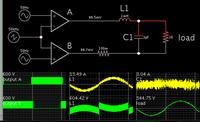Markobar
Newbie level 3
Hi everybody!
I have to design an inductor for the output filter (LC) of a 50Hz inverter (full bridge, vbus = 600V). The switching frequency is 50kHz and the output voltage is 230Vac. The RMS value of the current through the inductor is 8A.
Now the complicated part:
The current through the inductor has a low frequency component of 50Hz and a high frequency ripple of 50kHz. The ripple amplitude is mainly a function of the inductor value. The output capacitor value also changes the ripple amplitude, but much less than the inductor value (we can suppose C = 2.2uF or 4.4uF).
After some simulations, I get (the RMS value of the current is 8A):
For an inductor value of 200uH, the 50kHz ripple (pk-pk) is 14A
For an inductor value of 400uH, the 50kHz ripple (pk-pk) is 6.5A
For an inductor value of 600uH, the 50kHz ripple (pk-pk) is 4.5A
For an inductor value of 1mH, the 50kHz ripple (pk-pk) is 3A
What would be the best choice for the inductor value? (any value between 200 and 1000uH is possible)
And once the value has been determined, is there a commercial inductor (or two to be connected in parallel or series) fulfilling all the specifications or how would you do to build it (core material and shape, litz wire or not, turns, etc.)? The idea is to find a trade off between losses and size.
Thank you in advance!
I have to design an inductor for the output filter (LC) of a 50Hz inverter (full bridge, vbus = 600V). The switching frequency is 50kHz and the output voltage is 230Vac. The RMS value of the current through the inductor is 8A.
Now the complicated part:
The current through the inductor has a low frequency component of 50Hz and a high frequency ripple of 50kHz. The ripple amplitude is mainly a function of the inductor value. The output capacitor value also changes the ripple amplitude, but much less than the inductor value (we can suppose C = 2.2uF or 4.4uF).
After some simulations, I get (the RMS value of the current is 8A):
For an inductor value of 200uH, the 50kHz ripple (pk-pk) is 14A
For an inductor value of 400uH, the 50kHz ripple (pk-pk) is 6.5A
For an inductor value of 600uH, the 50kHz ripple (pk-pk) is 4.5A
For an inductor value of 1mH, the 50kHz ripple (pk-pk) is 3A
What would be the best choice for the inductor value? (any value between 200 and 1000uH is possible)
And once the value has been determined, is there a commercial inductor (or two to be connected in parallel or series) fulfilling all the specifications or how would you do to build it (core material and shape, litz wire or not, turns, etc.)? The idea is to find a trade off between losses and size.
Thank you in advance!
